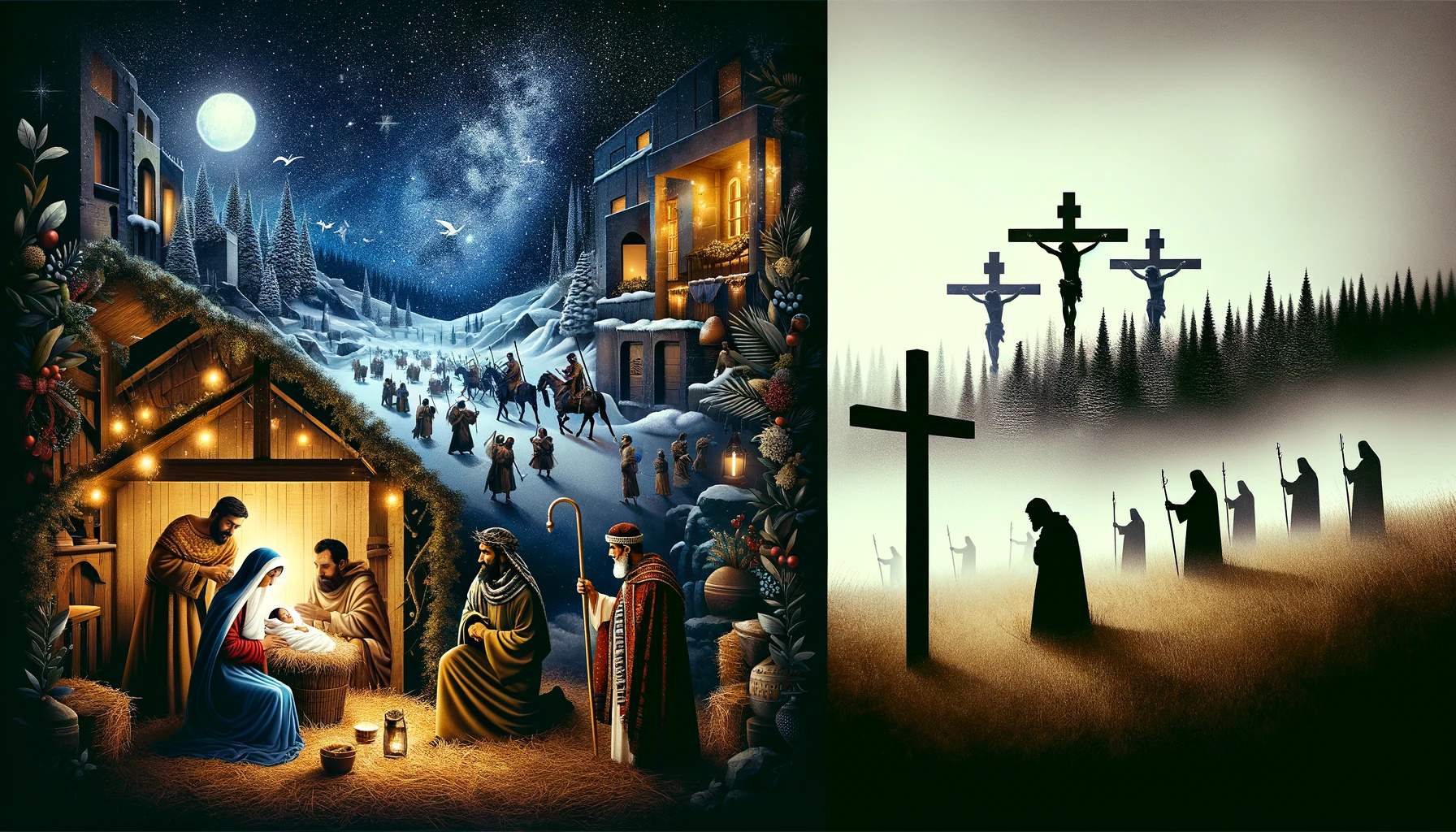Home>Special Themes>How Is Advent Different From Lent?


Special Themes
How Is Advent Different From Lent?
Published: February 12, 2024
Jason DeRose, Managing Editor at Christian.net, uses his expertise in religion and journalism to deepen understanding of faith's societal impacts. His editorial leadership, coupled with a strong academic background, enriches the platform’s diverse content, earning him recognition in both journalism and religious circles.
Discover the key differences between Advent and Lent, two special themes in the Christian calendar. Explore the unique significance and practices of each season.
(Many of the links in this article redirect to a specific reviewed product. Your purchase of these products through affiliate links helps to generate commission for Christian.net, at no extra cost. Learn more)
Table of Contents
Introduction
Advent and Lent are two significant periods in the Christian liturgical calendar, each holding its own distinct significance and observances. These seasons are marked by unique traditions and practices that hold deep spiritual meaning for believers. Understanding the differences between Advent and Lent is essential for grasping the rich tapestry of Christian faith and the rhythms of the church year.
During the Advent season, Christians joyfully anticipate the celebration of the birth of Jesus Christ, while Lent is a period of solemn reflection and preparation for the commemoration of Christ's death and resurrection. These seasons serve as poignant reminders of the central events in the Christian narrative and provide a framework for spiritual growth and contemplation.
As we delve into the origins, purposes, durations, timing, observances, and traditions of Advent and Lent, we will gain a deeper appreciation for the unique roles these seasons play in the lives of believers. Let's embark on a journey to explore the distinct characteristics and spiritual significance of Advent and Lent, uncovering the beauty and depth of these sacred seasons.
Read more: How Is Advent Different From Lent
Origins of Advent and Lent
Advent, originating from the Latin word "adventus," meaning "coming" or "arrival," traces its roots back to the 4th and 5th centuries in Gaul (modern-day France). It was initially observed as a period of preparation for the feast of Epiphany, commemorating the manifestation of Jesus Christ to the world. Over time, the focus shifted to preparing for the celebration of Christ's birth on Christmas Day. The early Christians viewed Advent as a time of spiritual preparation, penitence, and joyful anticipation, mirroring the longing of the Israelites for the coming of the Messiah.
On the other hand, Lent has its origins in the early church, with evidence of its observance dating back to the 2nd century. The word "Lent" is derived from the Old English word "lencten," meaning "spring," signifying a season of renewal and growth. The 40-day period of Lent mirrors the 40 days Jesus spent fasting in the wilderness, as recounted in the Gospels of Matthew, Mark, and Luke. This season was initially observed as a time of fasting and preparation for the baptism of new believers at the Easter Vigil. Over time, Lent evolved into a period of repentance, self-examination, and spiritual discipline, leading up to the commemoration of Christ's crucifixion and resurrection.
Both Advent and Lent have deep historical and theological significance, rooted in the early traditions of the Christian church. These seasons have evolved over centuries, incorporating diverse cultural practices and liturgical elements while remaining steadfast in their core themes of anticipation, preparation, and spiritual introspection. Understanding the historical origins of Advent and Lent provides valuable context for appreciating their enduring relevance and impact on the faith and spiritual lives of believers across denominations and traditions.
Purpose of Advent and Lent
Advent and Lent serve distinct yet complementary purposes within the Christian liturgical calendar, offering believers profound opportunities for spiritual growth, reflection, and renewal.
Purpose of Advent:
Advent, the season of joyful anticipation, serves as a time of preparation for the celebration of the birth of Jesus Christ. It encapsulates the dual nature of anticipation, looking back to the historical event of Christ's incarnation and forward to his promised return. The overarching purpose of Advent is to cultivate a spirit of hope, joy, and expectation as believers await the fulfillment of God's redemptive plan. It provides a sacred space for individuals and communities to reflect on the profound significance of the Incarnation, embracing the mystery of God taking on human flesh to dwell among humanity. Through the observance of Advent, Christians are invited to rekindle their faith, renew their sense of wonder at the nativity, and reorient their hearts toward the transformative power of Christ's coming into the world.
Purpose of Lent:
In contrast, Lent is characterized by solemnity and introspection, calling believers to engage in a season of repentance, self-examination, and spiritual discipline. The primary purpose of Lent is to prepare the hearts and minds of individuals for the observance of Christ's passion, death, and resurrection during Holy Week and Easter. It serves as a period of deep reflection on the human condition, the need for redemption, and the sacrificial love demonstrated through Christ's ultimate act of atonement. Lent invites believers to embark on a journey of spiritual renewal, embracing practices such as fasting, prayer, and almsgiving as a means of drawing closer to God and aligning their lives with the values of the Kingdom. Through the observance of Lent, Christians are encouraged to confront their shortcomings, seek reconciliation, and embrace the transformative power of God's grace, ultimately leading to a renewed sense of purpose and commitment to living out their faith in tangible ways.
Both Advent and Lent play pivotal roles in shaping the spiritual landscape of the Christian journey, offering believers distinct opportunities to engage with the foundational narratives of the faith. While Advent fosters a spirit of joyful expectation and hopeful anticipation, Lent calls for a season of introspection, repentance, and renewal. Together, these seasons form a holistic rhythm of spiritual life, guiding individuals through the cyclical themes of waiting, preparation, redemption, and resurrection, ultimately enriching their faith and deepening their relationship with God.
Duration and Timing of Advent and Lent
The duration and timing of Advent and Lent are intricately woven into the fabric of the Christian liturgical calendar, each season bearing its own unique temporal characteristics and significance.
Duration and Timing of Advent:
Advent typically spans four Sundays, beginning on the Sunday closest to November 30th and culminating on Christmas Eve. This period encompasses a total of four weeks, symbolizing the centuries-long anticipation of the coming Messiah. The timing of Advent holds profound symbolism, as it marks the commencement of the church year and serves as a poignant reminder of the ancient longing for the fulfillment of God's promises. The lighting of the Advent wreath, the use of special liturgical colors, and the progression of Scripture readings all contribute to the rich tapestry of Advent, guiding believers through a season of expectant waiting and spiritual preparation.
Duration and Timing of Lent:
In contrast, Lent unfolds over a 40-day period, mirroring the 40 days Jesus spent fasting in the wilderness. This season commences on Ash Wednesday and concludes on Holy Saturday, the day before Easter Sunday. The timing of Lent aligns with the traditional practices of fasting, self-examination, and repentance, as believers journey through a period of intense spiritual introspection and preparation for the commemoration of Christ's passion, death, and resurrection. The observance of Lent is marked by distinctive practices such as the imposition of ashes, the abstention from certain foods, and the emphasis on acts of charity and self-denial, all of which contribute to the profound significance of this season.
The temporal rhythms of Advent and Lent are deeply rooted in the historical and theological narratives of the Christian faith, offering believers structured opportunities to engage with the foundational events of the Incarnation and the redemptive work of Christ. The deliberate duration and timing of these seasons serve as a means of guiding individuals through a deliberate and intentional journey of faith, fostering a deeper understanding of the mysteries of the Christian narrative and providing a framework for spiritual growth and contemplation.
As believers immerse themselves in the distinct temporal landscapes of Advent and Lent, they are invited to embrace the cyclical rhythms of waiting, preparation, repentance, and renewal, ultimately enriching their spiritual lives and deepening their connection to the timeless truths of the Christian faith.
The duration and timing of Advent and Lent are not arbitrary, but rather intentional and purposeful, serving as integral components of the Christian journey and providing a framework for engaging with the sacred narratives of the faith. These seasons, with their unique temporal characteristics, offer believers structured opportunities for spiritual growth, reflection, and renewal, enriching their understanding of the foundational events of the Christian narrative and guiding them through a deliberate and intentional journey of faith.
Observances and Traditions of Advent and Lent
Read more: How Are The Gospels Different
Observances and Traditions of Advent:
Advent is marked by a rich tapestry of observances and traditions that serve to deepen the spiritual significance of the season. One of the most recognizable symbols of Advent is the Advent wreath, typically adorned with four candles, each representing a different aspect of the season: hope, peace, joy, and love. As the weeks progress, an additional candle is lit, signifying the incremental approach of Christmas. The lighting of the Advent candles accompanies the reading of Scripture and prayers, fostering a sense of anticipation and reflection.
Another prominent observance of Advent is the use of the Advent calendar, a cherished tradition that traces its origins to 19th-century Germany. Advent calendars feature a series of numbered doors or compartments, each concealing a small gift or treat. As each day of Advent is marked, individuals and families engage in the joyful anticipation of Christmas, savoring the daily unveiling of surprises and cultivating a spirit of expectancy.
Furthermore, the liturgical color associated with Advent is purple, symbolizing penitence, preparation, and royalty. This distinctive color adorns the vestments of clergy, the paraments in churches, and other decorative elements, serving as a visual reminder of the solemn yet hopeful nature of the season.
Observances and Traditions of Lent:
Lent is characterized by a set of observances and traditions that guide believers through a period of spiritual introspection and preparation. One of the most recognizable symbols of Lent is the imposition of ashes on Ash Wednesday, signifying repentance and mortality. The ashes, typically derived from the burning of palm branches from the previous year's Palm Sunday, are marked on the foreheads of worshippers in the shape of a cross, serving as a poignant reminder of human frailty and the need for redemption.
Fasting and abstinence are also central observances of Lent, with many believers choosing to abstain from certain foods or activities as a means of spiritual discipline and self-denial. This practice is often accompanied by an emphasis on acts of charity and almsgiving, encouraging individuals to extend compassion and generosity to those in need.
The liturgical color associated with Lent is purple, symbolizing penitence and preparation, with the color red being used on Palm Sunday and Good Friday to signify the events of Christ's passion. These distinctive colors serve as visual cues, guiding worshippers through the solemn and reflective nature of the Lenten season.
Both Advent and Lent are adorned with a rich tapestry of observances and traditions, each contributing to the unique spiritual landscape of these sacred seasons. These practices serve to deepen the spiritual significance of Advent and Lent, guiding believers through a deliberate and intentional journey of faith, reflection, and renewal.
The observances and traditions of Advent and Lent are not merely symbolic rituals but rather integral components of the Christian journey, providing believers with tangible expressions of faith and opportunities for spiritual growth and contemplation. As individuals and communities engage with these sacred observances, they are invited to immerse themselves in the timeless narratives of the Christian faith, embracing the cyclical rhythms of waiting, preparation, repentance, and renewal.
Conclusion
In conclusion, the distinct characteristics of Advent and Lent offer believers profound opportunities for spiritual growth, reflection, and renewal. These seasons, with their rich historical origins, serve as integral components of the Christian liturgical calendar, guiding individuals through a deliberate and intentional journey of faith.
Advent, with its focus on joyful anticipation and preparation for the celebration of Christ's birth, invites believers to cultivate a spirit of hope, joy, and expectation. The season serves as a poignant reminder of the ancient longing for the fulfillment of God's promises, encouraging individuals to rekindle their faith and reorient their hearts toward the transformative power of Christ's coming into the world.
On the other hand, Lent, characterized by solemnity and introspection, calls for a season of repentance, self-examination, and spiritual discipline. This period of deep reflection on the human condition and the need for redemption provides believers with an opportunity to confront their shortcomings, seek reconciliation, and embrace the transformative power of God's grace.
The deliberate duration and timing of Advent and Lent, along with their distinct observances and traditions, serve to deepen the spiritual significance of these seasons. From the lighting of the Advent wreath and the use of the Advent calendar to the imposition of ashes on Ash Wednesday and the emphasis on fasting and almsgiving during Lent, these practices guide believers through a deliberate and intentional journey of faith, reflection, and renewal.
As individuals and communities engage with the cyclical rhythms of waiting, preparation, repentance, and renewal, they are invited to immerse themselves in the timeless narratives of the Christian faith. The enduring relevance of Advent and Lent lies in their ability to enrich the spiritual lives of believers, deepening their connection to the foundational events of the Christian narrative and fostering a renewed sense of purpose and commitment to living out their faith in tangible ways.
In essence, Advent and Lent stand as pillars of the Christian faith, offering believers structured opportunities for spiritual growth, reflection, and renewal. These sacred seasons, with their unique purposes, observances, and traditions, continue to shape the spiritual landscape of the Christian journey, guiding individuals through the cyclical rhythms of anticipation, preparation, repentance, and renewal, ultimately enriching their faith and deepening their relationship with God.













